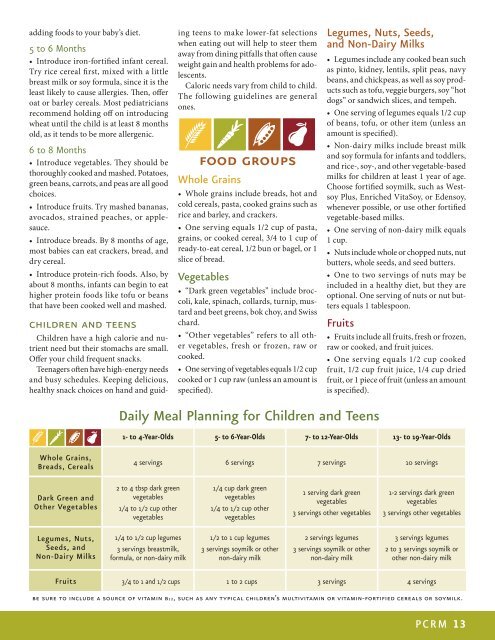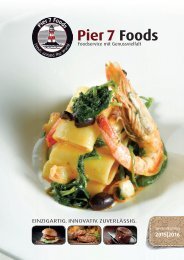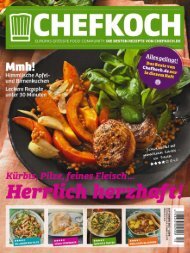testff
testfff
testfff
You also want an ePaper? Increase the reach of your titles
YUMPU automatically turns print PDFs into web optimized ePapers that Google loves.
adding foods to your baby’s diet.<br />
5 to 6 Months<br />
• Introduce iron-fortified infant cereal.<br />
Try rice cereal first, mixed with a little<br />
breast milk or soy formula, since it is the<br />
least likely to cause allergies. Then, offer<br />
oat or barley cereals. Most pediatricians<br />
recommend holding off on introducing<br />
wheat until the child is at least 8 months<br />
old, as it tends to be more allergenic.<br />
6 to 8 Months<br />
• Introduce vegetables. They should be<br />
thoroughly cooked and mashed. Potatoes,<br />
green beans, carrots, and peas are all good<br />
choices.<br />
• Introduce fruits. Try mashed bananas,<br />
avocados, strained peaches, or applesauce.<br />
• Introduce breads. By 8 months of age,<br />
most babies can eat crackers, bread, and<br />
dry cereal.<br />
• Introduce protein-rich foods. Also, by<br />
about 8 months, infants can begin to eat<br />
higher protein foods like tofu or beans<br />
that have been cooked well and mashed.<br />
children and teens<br />
Children have a high calorie and nutrient<br />
need but their stomachs are small.<br />
Offer your child frequent snacks.<br />
Teenagers often have high-energy needs<br />
and busy schedules. Keeping delicious,<br />
healthy snack choices on hand and guid-<br />
Whole Grains,<br />
Breads, Cereals<br />
Dark Green and<br />
Other Vegetables<br />
Legumes, Nuts,<br />
Seeds, and<br />
Non-Dairy Milks<br />
ing teens to make lower-fat selections<br />
when eating out will help to steer them<br />
away from dining pitfalls that often cause<br />
weight gain and health problems for adolescents.<br />
Caloric needs vary from child to child.<br />
The following guidelines are general<br />
ones.<br />
food groups<br />
Whole Grains<br />
• Whole grains include breads, hot and<br />
cold cereals, pasta, cooked grains such as<br />
rice and barley, and crackers.<br />
• One serving equals 1/2 cup of pasta,<br />
grains, or cooked cereal, 3/4 to 1 cup of<br />
ready-to-eat cereal, 1/2 bun or bagel, or 1<br />
slice of bread.<br />
Vegetables<br />
• “Dark green vegetables” include broccoli,<br />
kale, spinach, collards, turnip, mustard<br />
and beet greens, bok choy, and Swiss<br />
chard.<br />
• “Other vegetables” refers to all other<br />
vegetables, fresh or frozen, raw or<br />
cooked.<br />
• One serving of vegetables equals 1/2 cup<br />
cooked or 1 cup raw (unless an amount is<br />
specified).<br />
Daily Meal Planning for Children and Teens<br />
Legumes, Nuts, Seeds,<br />
and Non-Dairy Milks<br />
• Legumes include any cooked bean such<br />
as pinto, kidney, lentils, split peas, navy<br />
beans, and chickpeas, as well as soy products<br />
such as tofu, veggie burgers, soy “hot<br />
dogs” or sandwich slices, and tempeh.<br />
• One serving of legumes equals 1/2 cup<br />
of beans, tofu, or other item (unless an<br />
amount is specified).<br />
• Non-dairy milks include breast milk<br />
and soy formula for infants and toddlers,<br />
and rice-, soy-, and other vegetable-based<br />
milks for children at least 1 year of age.<br />
Choose fortified soymilk, such as Westsoy<br />
Plus, Enriched VitaSoy, or Edensoy,<br />
whenever possible, or use other fortified<br />
vegetable-based milks.<br />
• One serving of non-dairy milk equals<br />
1 cup.<br />
• Nuts include whole or chopped nuts, nut<br />
butters, whole seeds, and seed butters.<br />
• One to two servings of nuts may be<br />
included in a healthy diet, but they are<br />
optional. One serving of nuts or nut butters<br />
equals 1 tablespoon.<br />
Fruits<br />
• Fruits include all fruits, fresh or frozen,<br />
raw or cooked, and fruit juices.<br />
• One serving equals 1/2 cup cooked<br />
fruit, 1/2 cup fruit juice, 1/4 cup dried<br />
fruit, or 1 piece of fruit (unless an amount<br />
is specified).<br />
1- to 4-Year-Olds 5- to 6-Year-Olds 7- to 12-Year-Olds 13- to 19-Year-Olds<br />
4 servings 6 servings 7 servings 10 servings<br />
2 to 4 tbsp dark green<br />
vegetables<br />
1/4 to 1/2 cup other<br />
vegetables<br />
1/4 to 1/2 cup legumes<br />
3 servings breastmilk,<br />
formula, or non-dairy milk<br />
1/4 cup dark green<br />
vegetables<br />
1/4 to 1/2 cup other<br />
vegetables<br />
1/2 to 1 cup legumes<br />
3 servings soymilk or other<br />
non-dairy milk<br />
1 serving dark green<br />
vegetables<br />
3 servings other vegetables<br />
2 servings legumes<br />
3 servings soymilk or other<br />
non-dairy milk<br />
1-2 servings dark green<br />
vegetables<br />
3 servings other vegetables<br />
3 servings legumes<br />
2 to 3 servings soymilk or<br />
other non-dairy milk<br />
Fruits 3/4 to 1 and 1/2 cups 1 to 2 cups 3 servings 4 servings<br />
be sure to include a source of vitamin b12, such as any typical children’s multivitamin or vitamin-fortified cereals or soymilk.<br />
PCRM 13

















